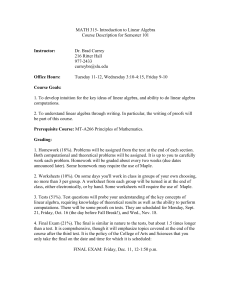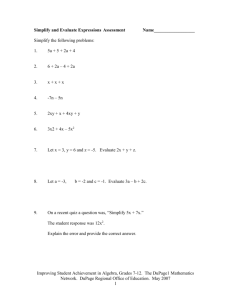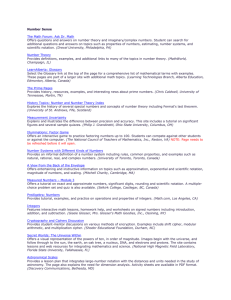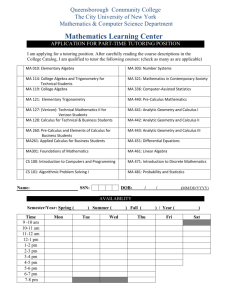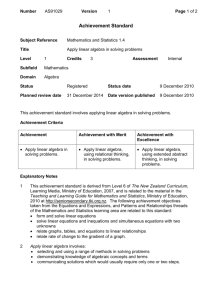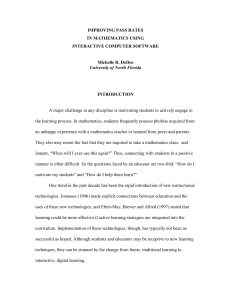Making Decisions about Course Sequences and the New Model
advertisement
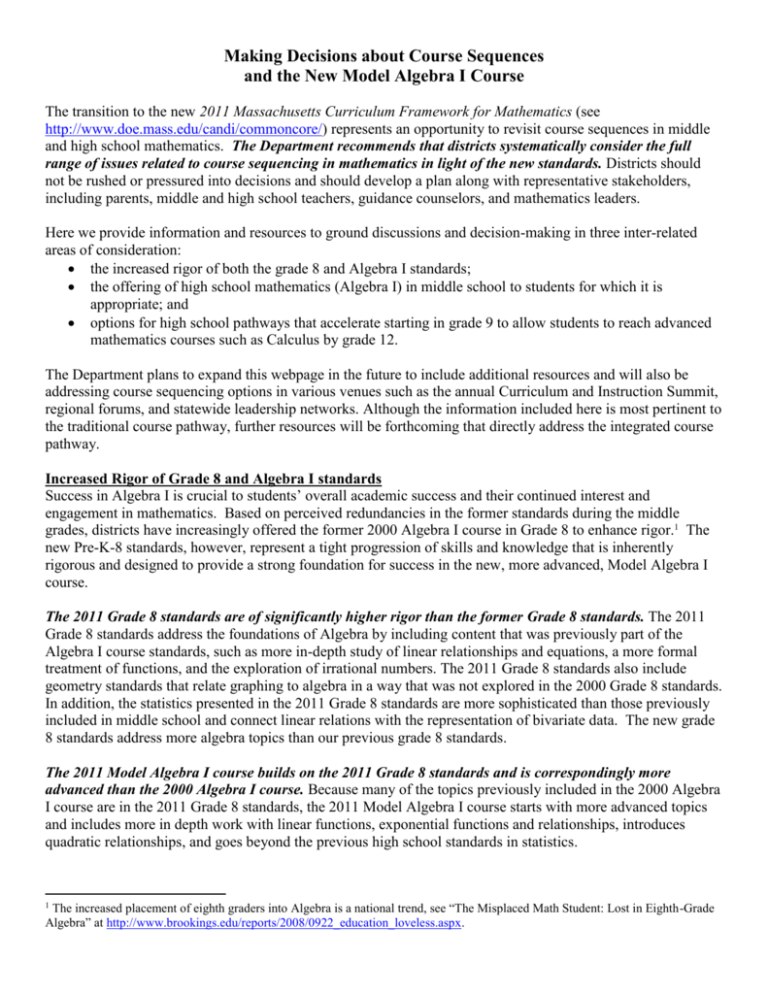
Making Decisions about Course Sequences and the New Model Algebra I Course The transition to the new 2011 Massachusetts Curriculum Framework for Mathematics (see http://www.doe.mass.edu/candi/commoncore/) represents an opportunity to revisit course sequences in middle and high school mathematics. The Department recommends that districts systematically consider the full range of issues related to course sequencing in mathematics in light of the new standards. Districts should not be rushed or pressured into decisions and should develop a plan along with representative stakeholders, including parents, middle and high school teachers, guidance counselors, and mathematics leaders. Here we provide information and resources to ground discussions and decision-making in three inter-related areas of consideration: the increased rigor of both the grade 8 and Algebra I standards; the offering of high school mathematics (Algebra I) in middle school to students for which it is appropriate; and options for high school pathways that accelerate starting in grade 9 to allow students to reach advanced mathematics courses such as Calculus by grade 12. The Department plans to expand this webpage in the future to include additional resources and will also be addressing course sequencing options in various venues such as the annual Curriculum and Instruction Summit, regional forums, and statewide leadership networks. Although the information included here is most pertinent to the traditional course pathway, further resources will be forthcoming that directly address the integrated course pathway. Increased Rigor of Grade 8 and Algebra I standards Success in Algebra I is crucial to students’ overall academic success and their continued interest and engagement in mathematics. Based on perceived redundancies in the former standards during the middle grades, districts have increasingly offered the former 2000 Algebra I course in Grade 8 to enhance rigor.1 The new Pre-K-8 standards, however, represent a tight progression of skills and knowledge that is inherently rigorous and designed to provide a strong foundation for success in the new, more advanced, Model Algebra I course. The 2011 Grade 8 standards are of significantly higher rigor than the former Grade 8 standards. The 2011 Grade 8 standards address the foundations of Algebra by including content that was previously part of the Algebra I course standards, such as more in-depth study of linear relationships and equations, a more formal treatment of functions, and the exploration of irrational numbers. The 2011 Grade 8 standards also include geometry standards that relate graphing to algebra in a way that was not explored in the 2000 Grade 8 standards. In addition, the statistics presented in the 2011 Grade 8 standards are more sophisticated than those previously included in middle school and connect linear relations with the representation of bivariate data. The new grade 8 standards address more algebra topics than our previous grade 8 standards. The 2011 Model Algebra I course builds on the 2011 Grade 8 standards and is correspondingly more advanced than the 2000 Algebra I course. Because many of the topics previously included in the 2000 Algebra I course are in the 2011 Grade 8 standards, the 2011 Model Algebra I course starts with more advanced topics and includes more in depth work with linear functions, exponential functions and relationships, introduces quadratic relationships, and goes beyond the previous high school standards in statistics. The increased placement of eighth graders into Algebra is a national trend, see “The Misplaced Math Student: Lost in Eighth-Grade Algebra” at http://www.brookings.edu/reports/2008/0922_education_loveless.aspx. 1 A document comparing the 2011 Grade 8 standards with the 2000 Algebra I standards is available at http://www.doe.mass.edu/candi/commoncore/?section=comparison. This tool helps to clarify the extent to which 2000 Algebra I content is now included in the 2011 Grade 8 standards. High School Mathematics in Middle School Students who have demonstrated the ability to meet the full expectations of the standards quickly should, of course, be encouraged to do so. There should also be a variety of ways and opportunities for students to advance to mathematics courses beyond those included in the 2011 Framework. Districts are encouraged to work with their mathematics leadership, teachers, and curriculum coordinators to design pathways that best meet the needs of their students. For those students ready to move at a more accelerated pace, one method that has been recommended by the writers of the Common Core State Standards is to compress the standards for any three consecutive grades and/or courses into an accelerated two-year pathway. The 2011 Mathematics Standards in grades 6-8 are coherent, rigorous, and non-redundant, so the offering of high school coursework in middle school to students for whom it is appropriate requires careful planning to ensure that all content and practice standards are fully addressed. The Common Core State Standards initiative has provided “compacted” pathways in which the standards from Grade 7, Grade 8, and the Model Algebra I (or Model Mathematics I) course could be compressed into an accelerated pathway for students in grades 7 and 8, allowing students to enter the Model Geometry (or Model Mathematics II) course in grade 9. The “compacted” pathways can be found in the document Common Core State Standards for Mathematics Appendix A: Designing High School Mathematics Courses Based on the Common Core State Standards, at http://www.corestandards.org/the-standards. The selection and placement of students into accelerated opportunities must be done carefully in order to ensure success. Students who follow a compacted pathway will be undertaking advanced work at an accelerated pace. This creates a challenge for these students as well as their teachers, who will be teaching within a compressed timeframe 8th Grade standards and Model Algebra I standards that are significantly more rigorous than in the past. The Department recommends that placement decisions are made based upon a common assessment to be reviewed by a team of stakeholders that includes teachers and instructional leadership. Accelerated High School Pathways High school mathematics will culminate for many students during 12th grade with courses such as Model Precalculus and/or Model Advanced Quantitative Reasoning. Although this would represent a robust and rigorous course of study, some students will seek the opportunity to advance to mathematics courses beyond those included in the 2011 Framework (for example, Discrete Mathematics, Linear Algebra, AP Statistics and/or AP Calculus). The following models are only some of the pathways by which students’ mathematical needs could be met. Districts are encouraged to work with their mathematics leadership, teachers, and curriculum coordinators to design pathways that best meet the abilities and needs of their students. For students who study the 8th grade standards in grade 8, there are pathways that will lead them to advanced mathematics courses in high school, such as Calculus. In high school, compressed and accelerated pathways may follow these models, among others: Students could “double up” by enrolling in the Model Geometry course during the same year as Model Algebra I or Model Algebra II; Standards from the Model Precalculus course could be added to other courses in a high school pathway, allowing students to enter a Calculus course without enrolling in the Model Precalculus course (a document showing how prerequisites to Calculus could be distributed among the other high school MA Department of Elementary and Secondary Education March, 2012 courses in an “Enhanced Pathway” can be found at http://www.doe.mass.edu/candi/commoncore/); Standards that focus on a sub-topic such as trigonometry or statistics could be pulled out and taken alongside the Model courses so that students would only need to “double up” for one semester; or Standards from the Model Mathematics I, Model Mathematics II, and Mathematics III course could be compressed into an accelerated pathway for students for two years, allowing students to enter the Model Precalculus course in the third year. This graphic depicts grades 6-12 for the first two options noted above in comparison to a pathway that compacts grade 7, grade 8 and Algebra I in middle school. Note that the accelerated high school pathways delay decisions about which students to accelerate while still allowing access to advanced mathematics in grade 12. Assessments The Partnership for Assessment of Readiness for College and Career (PARCC) assessments are in initial development. Information about future assessments will be communicated as it becomes available. More information can be found at http://www.parcconline.org/. Contact For questions or comments, please contact the STEM Office at mathsciencetech@doe.mass.edu. MA Department of Elementary and Secondary Education March, 2012

